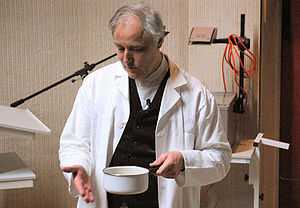Hervé This
| Hervé This | |
|---|---|
 The chemist Hervé This | |
| Born |
1955 Suresnes, Hauts-de-Seine |
| Nationality | French |
| Fields | Chemistry |
| Institutions | Institut National de la Recherche Agronomique |
| Known for | Molecular gastronomy |
With the late Nicholas Kurti, he coined the scientific term "Molecular and Physical Gastronomy" in 1988, which he shortened to "Molecular Gastronomy" after Kurti's death in 1998.[1] Graduated from École supérieure de physique et de chimie industrielles de la ville de Paris,[2] he obtained a Ph.D from the University Paris VI, under the title "La gastronomie moléculaire et physique".[3] He has written many scientific publications,[4] as well as several books on the subject, which can be understood even by those who have little or no knowledge of chemistry, but so far only four have been translated into English. He also collaborates with the magazine Pour la Science, the aim of which is to present scientific concepts to the general public. He is also a corresponding member of the Académie d'agriculture de France, and, more recently, the scientific director of the foundation "Food Science & Culture", which he created at the French Academy of Science. In 2011, he was elected as a Consulting Professor of AgroParisTech, and he was also asked to create courses on science and technology at Sciences Po Paris.
Some of his discoveries include the perfect temperature for cooking an egg[citation needed] (around 65 °C, the white coagulates, but not the yolk), and the use of an electrical field to improve the smoking of salmon. He also found that beating an egg white after adding a small amount of cold water considerably increases the amount of foam produced. Every month he adds one new "invention" in the Art et Science section of the website of the chef Pierre Gagnaire.[5]
Although his main focus is on physical chemistry, he also attributes great importance to the emotional aspect of cooking, as the title of one of his books shows: Cooking is love, art, technique.
The latest work by Hervé This, in conjunction with Pierre Gagnaire, has been the formation and promotion of Note by Note cuisine - the next stage in the application of science to the kitchen after molecular gastronomy. Note by note cooking involves taking the molecules that compose ingredients used in cooking, and using these as the raw ingredients for a dish. “If you use pure compounds, you open up billions and billions of new possibilities,” Mr This said. “It's like a painter using primary colours or a musician composing note by note.” [6]
As part of the 2011 International Year of Chemistry, The French Embassy in Ireland in association with the Institut Français, the Alliance Française Dublin, the Lycée Français d’Irlande and the French Trade Commission UBIFRANCE put on a number of lectures around Dublin, Ireland where Hervé This performed demonstrations and promoted the new concept of 'note by note' cuisine.[7]

Bibliography
- 1993 : les Secrets de la casserole, Éditions Belin
- 1995 : Révélations gastronomiques, Éditions Belin. ISBN 2-7011-1756-9
- 1997 : la Casserole des enfants, Éditions Belin
- 2002 : Traité élémentaire de cuisine, Éditions Belin
- 2002 : Casseroles et éprouvettes, Éditions Belin
- 2005 : Molecular Gastronomy: Exploring the Science of Flavor (translator: Malcolm DeBevoise), Cambridge University Press. ISBN 0-231-13312-X
- 2006 : La cuisine c'est de l'amour, de l'art, de la technique, Odile Jacob
- 2007 : Construisons un repas, Odile Jacob
- 2007 : De la science aux fourneaux, Pour la Science/Editions Belin
- 2007 : Kitchen Mysteries: Revealing the Science of Cooking (translator: Jody Glading), Columbia University Press. ISBN 978-0-231-14170-3 or 023114170X
- 2007 : Alchimistes aux fourneaux, Flammarion
- 2009 : "Building a Meal: From Molecular Gastronomy to Culinary Constructivism (Arts and Traditions of the Table: Perspectives on Culinary History)" (translator: Malcolm DeBevoise), Columbia University Press. ISBN 978-0-231-14466-7
- 2009 : Cours de gastronomie moléculaire n°1 : Science, technologie, technique (culinaires) : quelles relations?, Quae/Belin, Paris.
- 2011 : Cours de gastronomie moléculaire n°2 : Les Précisions culinaires, Quae/Belin, Paris.
- 2012 : La cuisine note à note en douze questions souriantes, Belin, Paris.
References
- ↑ This, Hervé (2005). Molecular Gastronomy: Exploring the Science of Flavor. Columbia University Press. ISBN 0-231-13312-X.
- ↑ ESPCI ParisTech Alumni 1980
- ↑ La gastronomie moléculaire et physique = Molecular and physical gastronomy (French)
- ↑ Portion of This' published work
- ↑ Art et Science (French)
- ↑ Savage, Michael. The Times (London) http://www.timesonline.co.uk/tol/news/world/europe/article6128617.ece
|url=missing title (help). - ↑ http://www.ambafrance-ie.org/spip.php?article1703
External links
- Hervé This blog(French)
- La gastronomie moléculaire Hervé This page at INRA (French)
- Fondation Science & Culture Alimentaire (French)
- Cours de gastronomie moléculaire (French)
- Molecular Gastronomy Seminar with Hervé This
|